Ten hours: That’s about how much time passed between a 56-year-old woman’s call to 911 to report she had been rear-ended on Southeast 148th Avenue and the publication of a slew of news stories with headlines like “Cop-Hating Portland City Councilor Involved in Hit-and-Run Accident.”
Two hundred thirty days: That’s how long ago the Portland Police Bureau determined Commissioner Jo Ann Hardesty was not, in fact, a suspect in the fender-bender.
“What happened to Commissioner Hardesty is wrong and unacceptable,” Mayor Ted Wheeler said March 5. “It’s a reflection of broader systemic racism and it must be addressed. We need to get to the bottom of it as soon as possible. No one should be subjected to false accusations publicly.”
Since the mayor issued that statement 32 weeks ago, the Blazers lost a playoff series, Portland experienced the hottest temperatures in recorded history, and an attempt to recall Wheeler failed.
Yet Portlanders still don’t have answers about how the false allegation made its way within hours to right-wing social media pundits, and later to The Oregonian. Nor do we know definitively why Officer Brian Hunzeker resigned as president of the city’s police union, the Portland Police Association, on March 16 for his purported role in the leak.
But the answers to those questions, which have lingered like a Willamette Valley fog for more than seven months, may soon be voted on by a five-to-seven-member board.
On Oct. 20, the city’s Police Review Board is slated to determine what discipline, if any, the involved officers should face. Within 14 days of completing the case review, the board’s “civilian facilitator” is required to submit proposed findings in writing to Police Chief Chuck Lovell, who can then affirm or deny the board’s findings and issue a final decision.
If the chief’s decision imposes discipline on the involved officers, the union could file a grievance on their behalf, which could drag the decision into arbitration.
The chief’s decision is quasi-public, meaning the officers’ names will likely be redacted, and the explanations of what actions specifically violated city policies are typically condensed to the point of being nonsensical. But the PRB hearing at the very least represents forward movement in a set of investigations that appeared inert.
The investigation’s conclusion was news to Hardesty.
“I learned the most recent update that the investigation had concluded and is scheduled for a PRB hearing from The Oregonian,” she says. Similarly, back in March, Hardesty says she first learned of the hit-and-run allegation when the city’s sole daily contacted her for comment.
Hardesty says she now knows as much as the public does about the case.
“I received only one physical letter sent to my City Hall office dated July 29 that said the investigation had concluded,” she says.
Because she and her staff were working remotely at the time, Hardesty only learned of the letter in September. As WW reported last month, the letter notified the commissioner that the investigation had concluded. Then in a subsequent conversation with Chief Lovell, Hardesty says, he told her that a tort claim notice she filed against the city in August had prompted the Police Bureau to reopen the investigation.
Besides the July 29 letter and the conversation with the chief, Hardesty says, the bureau has not provided her any information about the investigation. Her attorney Matthew Ellis asked—and was denied—permission to attend Wednesday’s PRB hearing.
That raises questions about what information will be released to the public, and when, regarding the case.
City Attorney Robert Taylor said in a statement Monday that the city anticipates the press will request the relevant records from the Police Bureau “once the full disciplinary process is complete.”
“The city understands the high public interest in this matter and has been committed to a full and thorough investigation of this incident,” Taylor says. “The city will review those requests and respond as allowed by law, and the city’s response will be informed by the high public interest in this matter.”
Taylor did not respond to WW’s questions about whether his office has legal authority to compel the release of the internal affairs file, among other relevant records.
Meanwhile, PPB has declined to disclose the date that its internal affairs investigation concluded. On Oct. 12, the bureau confirmed in an email to WW that the investigation was still ongoing, so it is unclear if the investigation wrapped in the 48-odd hours between then and The Oregonian’s report on Oct. 14, or if the Police Bureau provided incorrect information to WW, which inquires with the bureau weekly about the status of the internal affairs probe.
PPB spokesman Sgt. Kevin Allen warns that the Police Review Board hearing won’t necessarily mark the conclusion of the case.
“It will be some time yet before the entire process concludes,” Allen says. “The process is important to ensure the integrity of the investigation. That’s why it’s not accurate to say that the case is ‘shrouded in secrecy’ as has been reported.
“That is normal for IA investigations,” Allen continues. “They’re always confidential, and the final decision makers won’t know much about it until it reaches their stage because they can’t be seen as having any influence over the investigation. Remember that we only have one shot at a quality investigation, and we owe it to all who are involved to take the time to do it right.”
But the quality of justice delivered by the PRB—and the level of transparency in its results—is a matter of some debate.
In cases that do not involve use of force, the panel typically consists of three PPB officers (one peer of the involved officers, an assistant chief, and a captain or commander), one civilian, and a member of the city’s Independent Police Review.
Critics say the makeup of the panel is tilted in favor of police. “It’s a Police Review Board, it’s not a Community Review Board,” says Dan Handelman of Portland Copwatch.
“The membership is heavily weighted toward the police, it’s behind closed doors, the person involved can’t go: Those are some of the key problems. And then the information that we get out of them is very heavily redacted,” Handelman says. “The officer is allowed to go and have somebody from the PPA represent them. But the subject of what the police did is not allowed in. So that’s just horrifying in its own right.”
In March, the U.S. Department of Justice issued a letter criticizing the city’s interpretation and application of bureau directives during PRB hearings, after it sat in on multiple meetings of the board in 2020 and 2021.
“These repeated failures demonstrate a systemic inadequacy in the city’s accountability structure,” DOJ lawyers wrote. “The errors impact the city’s ability to hold officers to account for violating PPB policy.”
Ashlee Albies, a Portland civil rights lawyer who has reviewed PRB findings for litigation purposes, says the process occurs “behind a veil.”
“My perception is it’s usually designed to have a certain outcome,” Albies says. “I think it absolutely is functioning as it’s supposed to, as it was designed to. But whether it functions to provide additional transparency and oversight of the police—no, I don’t think it does that.”
Former Mayor Sam Adams, who is Wheeler’s director of strategic innovations, says the office at this time cannot respond to WW’s questions about whether or not the mayor believes the full investigative files should be released to the public.
“As the final decision maker on these matters, Mayor cannot comment on an open IA investigation,” Adams says. “The process still requires a few more steps before it lands on his desk for a final decision.”
Update: This story has been updated from the print version to include a comment from Mayor Wheeler’s office.

